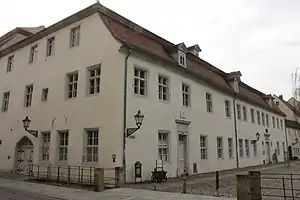Paul Eber
Paul Eber (8 November 1511 – 10 December 1569) was a German Lutheran theologian, reformer and hymnwriter, known for the hymn for the dying, "Herr Jesu Christ, wahr Mensch und Gott".
Paul Eber | |
|---|---|
 Eber, portrayed by Lucas Cranach the Younger | |
| Born | 8 November 1511 |
| Died | 10 December 1569 (aged 58) |
| Education | University of Wittenberg |
| Occupation |
|
| Organization | University of Wittenberg |


Life
He was born at Kitzingen in Franconia, and was educated at Nuremberg then Wittenberg, where he became the close friend of Philipp Melanchthon. In 1541 he was appointed professor of Latin grammar at Wittenberg, and in 1557 professor of the Old Testament at Wittenberg University. His range of learning was wide, and he published a handbook of Jewish history, a historical calendar intended to supersede the Roman Saints' Calendar, and a revision of the Latin Old Testament.[1]
In the theological conflict of the time he played a large part, doing what he could to mediate between the extremists. From 1559 to the close of his life he was superintendent general of the electorate of Saxony. He attained some fame as a hymn writer, his best-known composition being Wenn wir in höchsten Nöten sein.
In Wittenberg he lived on the north east corner of Kirchplatz/Judenstrasse, close to the Stadtkirche.[2]
He died at Wittenberg on 10 December 1569.[1] He is buried near the altar in St Mary's Church (Stadtkirche Wittenberg). The grave is less than 100m from his home.
Memorials
In 1573 Lucas Cranach the Younger created a memorial painting, showing Eber in the Garden of Gethsemane in the church.
Remembrance
Johann Sebastian Bach composed in 1725 a chorale cantata on his hymn in eight stanzas, Herr Jesu Christ, wahr' Mensch und Gott, BWV 127. Bach also composed a church cantata "Herr Gott, dich loben alle wir" BWV 130, based on the eponymous hymn in twelve stanzas by Paul Eber (1554).
References
- Chisholm 1911.
- Plaque to Paul Eber, Wittenberg
Bibliography
| Wikimedia Commons has media related to Paul Eber. |
 This article incorporates text from a publication now in the public domain: Chisholm, Hugh, ed. (1911). "Eber, Paul". Encyclopædia Britannica (11th ed.). Cambridge University Press.
This article incorporates text from a publication now in the public domain: Chisholm, Hugh, ed. (1911). "Eber, Paul". Encyclopædia Britannica (11th ed.). Cambridge University Press.
